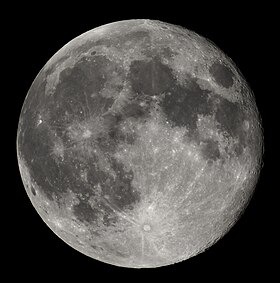 | ||||||||||
| Designations | ||||||||||
|---|---|---|---|---|---|---|---|---|---|---|
| Adjective | "lunar" | |||||||||
| Perigee | 363 104 km (0.002 4 AU) | |||||||||
| Apogee | 405 696 km (0.002 7 AU) | |||||||||
| Semi-major axis | 384 399 km (0.002 57 AU[1]) | |||||||||
| Eccentricity | 0.054 9[1] | |||||||||
| Orbital period | 27.321 582 d (27 d 7 h 43.1 min[1]) | |||||||||
| Synodic period | 29.530 588 d (29 d 12 h 44.0 min) | |||||||||
| Average orbital speed | 1.022 km/s | |||||||||
| Inclination | 5.145° to the ecliptic[1] (between 18.29° and 28.58° to Earth's equator) | |||||||||
| Longitude of ascending node | regressing by one revolution in 18.6 years | |||||||||
| Argument of perigee | progressing by one revolution in 8.85 years | |||||||||
| Satellite of | Earth | |||||||||
| Physical characteristics | ||||||||||
| Mean radius | 1 737.10 km (0.273 Earths)[1][2] | |||||||||
| Equatorial radius | 1 738.14 km (0.273 Earths)[2] | |||||||||
| Polar radius | 1 735.97 km (0.273 Earths)[2] | |||||||||
| Flattening | 0.001 25 | |||||||||
| Circumference | 10 921 km (equatorial) | |||||||||
| Surface area | 3.793 × 107 km² (0.074 Earths) | |||||||||
| Volume | 2.195 8 × 1010 km³ (0.020 Earths) | |||||||||
| Mass | 7.347 7 × 1022 kg (0.012 3 Earths[1]) | |||||||||
| Mean density | 3 346.4 kg/m³[1] | |||||||||
| Equatorial surface gravity | 1.622 m/s² (0.165 4 g) | |||||||||
| Escape velocity | 2.38 km/s | |||||||||
| Sidereal rotation period | 27.321 582 d (synchronous) | |||||||||
| Equatorial rotation velocity | 4.627 m/s | |||||||||
| Axial tilt | 1.542 4° (to ecliptic) 6.687° (to orbit plane) | |||||||||
| Albedo | 0.12 | |||||||||
| Surface temp. equator 85°N[5] |
| |||||||||
| Apparent magnitude | −2.5 to −12.9[3] −12.74 (mean full moon)[2] | |||||||||
| Angular diameter | 29.3 to 34.1 arcminutes[2][4] | |||||||||

Some details of the Earth-Moon system. Besides the radius of each object, the radius to the Earth-Moon barycenter is shown. Photos from NASA. Data from NASA. Planets aren't spheres and orbits aren't circles, so numbers are only indicative. The Moon's orbital plane precesses about the Earth in an 18.6 year cycle. Its axis is located by Cassini's third law.

Tidak ada komentar:
Posting Komentar